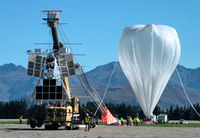A research team from the University of Toronto’s Dunlap Institute of Astronomy and Astrophysics and Department of Physics built a high-tech balloon-borne telescope, SuperBIT, to study the distribution of dark matter in galaxy clusters and large-scale clusters of the Universe. The Super-pressure Balloon-borne Imaging Telescope (SuperBIT) is a high-resolution telescope that operates in the stratosphere using NASA's super-pressure balloon system.
The balloon telescope was in space for more than 39 days collecting imagery and data, when the mission was abruptly ended due to conflicting wind predictions. The planned duration of the flight was 100 days. The telescope was brought down deliberately by the team overseeing its operation. SuperBIT landed in the remote hills of Argentina, in the mountainous desert – allowing for safe recovery of equipment and imagery onboard.
If the mission had continued, there was a risk of losing the equipment in Antarctica or the ocean. “…then we are going to lose power to the payload, the batteries will die, and when the batteries die it becomes a derelict, we can’t charge them once they are frozen, and we would have to drop so we didn’t have a derelict balloon floating around in the air space. So, we would end up dropping it either in the ocean or Antarctica” explains Prof. Netterfield. If the telescope drops in a waterbody, recovery is not possible.
A safe recovery from a balloon mission like SuperBIT can allow the team to re-launch and re-use it in future missions. The reusability and time to relaunch depends on how the landing and recovery was made. “The 2019 landing of SuperBIT was rough since it landed amongst trees and a lot of electronics did get stripped so they had to be remade (especially those on the outside of the telescope), as well as our mirrors that had to be rebuilt to ensure we can get quality science images. However, there was still a lot that could be reused (and was) as well, such as inner electronics and the structural frame of the gondola, and more. A lot of testing is done to ensure anything that has been flown before is capable of being flown again. Sometimes this can also be to our advantage since certain models of electronics can be tested in test flights to verify if they will work in subsequent flights or not” shared Emaad Paracha, a PhD student in the Department of Physics.
In a follow up interview, Prof. Netterfield said that the recovery in the 2023 mission had its own challenges, where a piece of the NASA/CSBF equipment failed, so the parachute did not properly disconnect from the payload on landing, causing the payload to drag in high winds over rough terrain for 2-3 km, basically destroying everything. The research team will have to rebuild the entire instrument before the next flight.
“The operation was successful and collected outstanding data” revealed Prof. Netterfield.
The mission was funded by NASA, the Canadian Space Agency, the Royal Society, and U of T's Dunlap Institute for Astronomy and Astrophysics.
The advantages of using a balloon telescope include eliminating almost all of Earth’s atmosphere to improve the resolution, and it is cheaper and faster to develop than trying to launch a telescope in space. SuperBIT costs about $10 million compared with the $87 million a year needed to keep the Hubble Telescope in orbit.
More information here (CityNews): https://archive.tveyes.com/18120/4553853-202376/e4d6a149-b69d-4f08-b92f-bf19d0771213/CACITYTOR_05-26-2023_18.45.33.mp4
More information here (CityNews 680 radio): https://archive.tveyes.com/18120/4553853-202376/191763d2-dc4f-4a33-a59e-a6cefa50794f/CARADCFTR_05-27-2023_00.25.30.mp3
More information here: https://www.physics.utoronto.ca/news-and-events/news/physics-news/first-space-images-captured-by-balloon-borne-telescope/
More information here: https://archive.tveyes.com/18120/4553853-202376/04a5d52f-5608-45f0-a313-0252bf9316d7/CACITYTOR_07-05-2023_17.57.15.mp4

